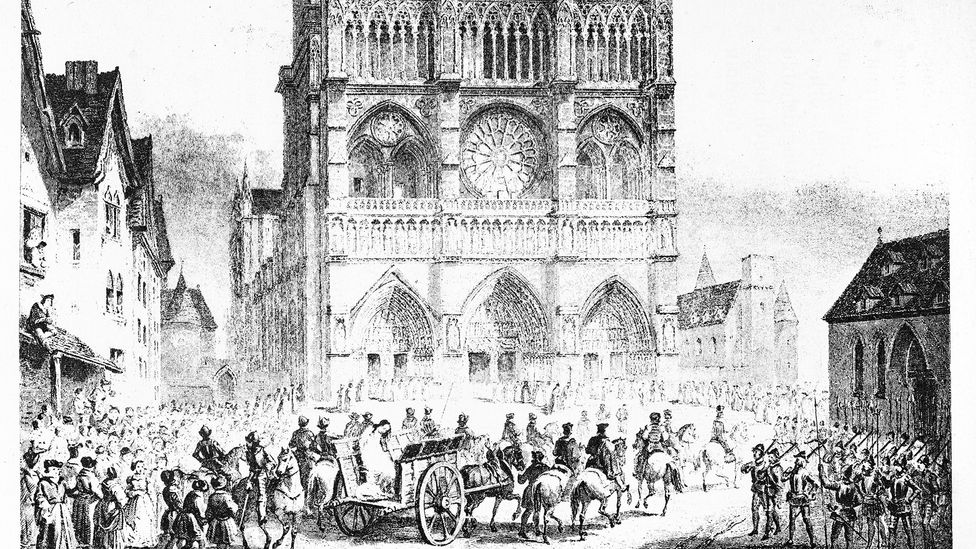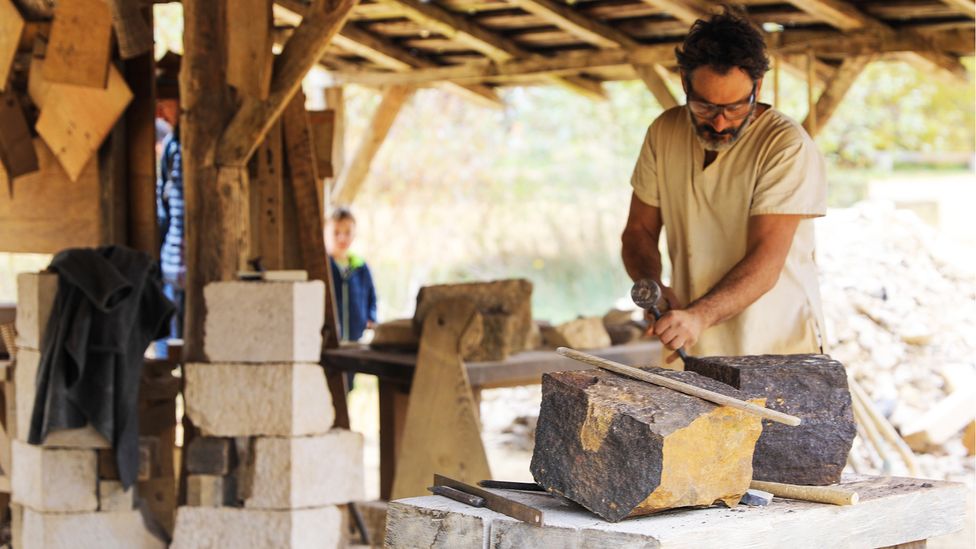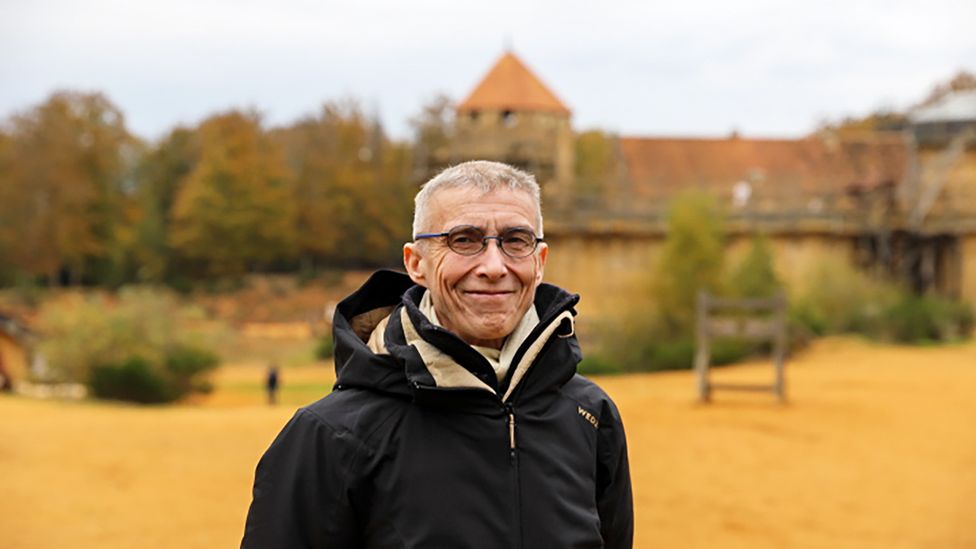Hooves click-clack on 18th-Century cobblestones as merchants haggle in the distance. Ever imagined the sounds that brought to life a place like Paris' Notre-Dame cathedral hundreds of years ago?
This is what Mylène Pardoën is trying to achieve. Based in the French city of Lyon, she introduces herself as a soundscape archaeologist, a profession she invented after she started questioning why museums often neglect using sound in their exhibits. Over the past 10 years, she has been scouring monuments and construction sites around the country and analysing acoustic environments to help her recreate sounds that allow us to travel back in time.
"I tell stories from the past not with words, but with sounds. So, there's a narrative aspect to my work, but never a fictional one," she explained, as her green eyes lit up under her small round glasses.
One of her biggest projects to date: working on restoring Notre Dame cathedral, which was severely damaged by a 2019 fire. The collapsed roof and burned upper walls have caused the cathedral to lose its "voice": its unique reverberance that commanded an almost sacred silence among visitors.
Pardoën's goal is to reproduce the everyday sounds that were heard inside and outside the cathedral, from its construction in the 13th Century until the 2019 fire. Working alongside a team of acoustics researchers and sound engineers, her findings will help the architects choose the materials and techniques used to restore Notre-Dame in order to make it "sound" like it used to.

There were animals like dogs and horses around the cathedral in the 18th Century (Credit: THEPALMER/Getty Images)
To find these noises, Pardoën has her nose buried deep in archives. "I dig into anything I can find from the time period I'm interested in. It can be paintings, sculptures, literature, even administrative documents to understand what everyday objects surrounded people and hence what noises could be heard," she said. "For example, we know from historical sources that there were animals like dogs and horses around the cathedral in the 18th Century. So, I'll go out and record sounds of those animals."
Currently, Notre Dame is closed to all research teams due to lead and asbestos removal. So, Pardoën found a new sound playground located deep in the forests of northern Burgundy, France. There, she could find sounds – mainly of replicas tools in action – from the Middle Ages.
A narrow, winding road leads to the entrance of Guédelon, one of the world's most unique castles. In 1997, a group of French medieval enthusiasts and friends had a little too much to drink over dinner one evening and decided to build a 13th-Century castle from scratch, using only tools and methods available during that period. Twenty-four years later, the castle – which is still under construction – is an unusual archaeological experiment attracting more than 300,000 tourists per year (pre-pandemic) and numerous academics such as Pardoën.

Workers at Guédelon castle use only tools and methods available during mediaeval times (Credit: Sophia Khatsenkova)
"There is a sort of music here. When everything's in harmony, you can hear it. But when there's a dissonance, you can hear it too," said Maryline Martin, one of Guédelon's co-founders, her words competing with the sounds of Guédelon employees working on the castle: a blacksmith hammering away and quarrymen smashing sandstone for the remaining tower. "Pardoën helps us pinpoint whether we are respecting the sounds of the 13th Century."
No workshop escapes Pardoën's ears, whether it's the carpenter cutting wood or the baker kneading dough. These recordings have several objectives. The first one, linked to Notre Dame, is to record the work of different craftspeople on site, such as masons, who were present inside and around the cathedral back in the Middle Ages.
You may also be interested in:
• The massive cost of saving Notre-Dame
• Will Paris ban cars?
• Is French cuisine forever changed?
This will help her recreate the ambiance of the cathedral during those times. These recordings will then be input into a computer simulation designed by a team of engineers, which will help to predict how materials and structural choices during the reconstruction might alter Notre-Dame's future acoustics. Even changes such as laying a carpet or using wood instead of metal for the vaults can dramatically change the cathedral's "voice".

Soundscape archaeologist Mylène Pardoën is reproducing sounds from the past (Credit: Sophia Khatsenkova)
The second is to classify these sounds into France's intangible cultural heritage. Unesco considers intangible cultural heritage as the practices and representations, as well as the knowledge and skills individuals recognise as part of their cultural heritage, such as craftsmanship or rituals.
"We need to safeguard these ancient professions. It's also part of passing them down generation to generation, from master to pupil," said Pardoën. "If this disappears, the chain breaks and it could take us 20 to 30 years to rediscover the gestures of a traditional craftsman back in the day. And understanding the past's sounds helps us understand history and the present even better."
Florian Renucci, philosopher turned master mason, explained that Pardoën's recording has been precious to the craftspeople in Guédelon. "It allows us to discover our job in another way. For example, when we listen to her recordings, we can tell whether we are doing a good or shoddy job just by listening to the sounds our tools make. It adds a whole new dimension to the project," he said.
The soundscape archaeologist is adamant that she is not a sound designer. "A lot of people think I invent sounds," Pardoën said. "That is not the case. I recover sounds of the past that can be found in the present."
---
Join more than three million BBC Travel fans by liking us on Facebook, or follow us on Twitter and Instagram.
If you liked this story, sign up for the weekly bbc.com features newsletter called "The Essential List". A handpicked selection of stories from BBC Future, Culture, Worklife and Travel, delivered to your inbox every Friday.
"sound" - Google News
November 17, 2021 at 05:20AM
https://ift.tt/3CoBrTN
The sounds rebuilding Notre Dame's precious vaults - BBC News
"sound" - Google News
https://ift.tt/2MmdHZm
Shoes Man Tutorial
Pos News Update
Meme Update
Korean Entertainment News
Japan News Update

No comments:
Post a Comment